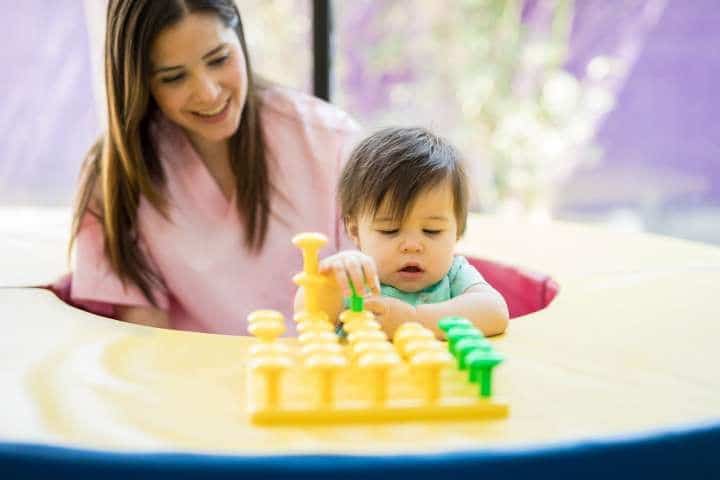What does ABA Therapy for Toddlers look like?
By: Mariela Tapia-Hernandez M.Ed., RBT
Reviewed by: Melanie Bren, M.Ed., BCBA, LBA

ABA or Applied Behavior Analysis is an evidence-based treatment for individuals with Autism Spectrum Disorder (ASD). Parents who might speculate their child is showing early signs of ASD should begin by getting a professional evaluation. Once a medical diagnosis is given for autism spectrum disorder, parents can consult with a qualified board-certified behavior analyst (BCBA). BCBA’s have extensive training in the principles of applied behavior analysis that has been successfully used in treatment for individuals with ASD.
An assessment is conducted before starting treatment to assess what skills the child is requiring across different domains. A BCBA will begin observing the child and collecting data to develop an individual treatment plan that best suits the child’s needs. Every child has a specialized program that adapts to their unique learning style. Goals may include reducing challenging behaviors (tantrums, resisting instructions, self-injurious, etc.) and increasing functional communication and social skills among peers.
ABA therapy is used to teach a variety of complex skills to individuals of all ages however, early intervention has been shown to produce excellent results when parent began ABA therapy before the ages of five years old. ABA teaches by breaking down skills into smaller steps that are manageable. Positive reinforcement is used to increase desirable behaviors. ABA therapy for toddlers can be conducted in various settings such as clinics, schools, homes, and even in the community.
Evidence Supporting ABA as a Treatment for Autism
Applied behavior analysis is proven to be a successful treatment for individuals with autism spectrum disorder. Interventions used in ABA therapy have an extensive amount of research that has demonstrated positive results for teaching skills and reducing challenging behaviors in individuals with ASD. ABA delivers only evidence-based practices that are high quality and harmless to the child’s development. Data is collected during every session to track the child’s progress on all their goals and behaviors.
A BCBA will consistently monitor the child’s progress to make data-driven decisions. They observe what approaches are working and whether the child treatment needs to be modified. ABA has a systematic approach when it comes to any decisions making. A BCBA will always considers the family’s values and preferences before developing an intervention. For treatment to be effective the family’s support is always encouraged in ABA therapy. Clinicians use their expertise to guide the parent through procedures and strategies that can be implemented by anyone at home and school.
Is my child too young for ABA?
Children can be diagnosed with Autism Spectrum Disorder (ASD) as early as 18 months. ABA treatment is suggested to parents once a diagnosis is given to the child. Early intervention has shown significant results in children who began at a young age. Some children are able to acquire substantial improvement to tolerate being in a neurotypical classroom.
A common misconception is that children sit at a table with a therapist for an extended period doing aversive tasks. This is not the case at all. ABA therapy primarily consists of play-based learning that incorporates the child’s specific goals simultaneously and should always be fun.
ABA Teaching Methods
Natural environment teaching (NET) is an instructional method that occurs in the natural environment. It is commonly used to help teach children with autism to increase their communication, social, and other skills. An ABA therapist will follow a child’s motivation and use their highest interests to create multiple learning opportunities. The child’s goals are embedded during play. NET is a technique used to generalize skills across different settings and people. NET should always be enjoyable since it is child-led.
Discrete Trial Training (DTT) consists of an ABA therapist working 1:1 with your child at a table, similar to a school setting structure. A therapist will slowly pair the table by having the child’s favorite items and preferred snacks available. Gradually, the therapist can increase the child’s tolerance for sitting at a table. Children receive multiple opportunities to learn new skills during discrete trial training.
A child gets positive reinforcement after correct attempts. Reinforcement is individualized to what the child prefers. They include social praise, edibles, preferred toys, and access to activities). Clinicians will continue to practice skills in a natural environment to promote generalization. The objective is for the child to be able to demonstrate learned skills across different settings and people.
What does ABA Therapy look like for toddlers?
Once your child begins ABA therapy for toddlers, a trained therapist will begin to connect with your child through play. A therapist will work on building a relationship with the child first. The first few session consist of “pairing”- building rapport and learning what activities and toys they enjoy best. Once the therapist is able to identify the child’s reinforcers, they can increase the likelihood of a behavior occurring in the future. Pairing is a crucial step in helping to gain instructional control- the therapist will create an enjoyable experience that will make the child want to follow their directions to gain access to the preferred reinforcers.
Once your child is comfortable and is excited to work with their therapist, they begin to work on specified goals established by a board-certified behavior analyst. Goals are continuously being added to your child’s program as old ones become mastered. BCBA’s use assessment tools to measure the child’s language and learning skills. They continue to teach age-appropriate skills based on what your child is missing.
During therapy, the clinician spends the majority of time being with your child one-on-one. They also create opportunities for your child to interact with other peers in social settings. During social interactions, the therapist contrives situations for the child to practice taking turns, sharing, joint attention, and communicating appropriately with other peers.
During ABA sessions, your child may also work on daily living skills such as toilet training, hygiene, and increasing tolerance to non-preferred food. An ABA therapist spends time teaching children to follow step-by-step directions such as brushing teeth, changing clothes, putting on shoes. This type of therapy helps your child become independent and provides a better quality of life for your child’s future.
Date Posted:
June 14, 2021
Share this blog
Categories
Recent Blog Posts








